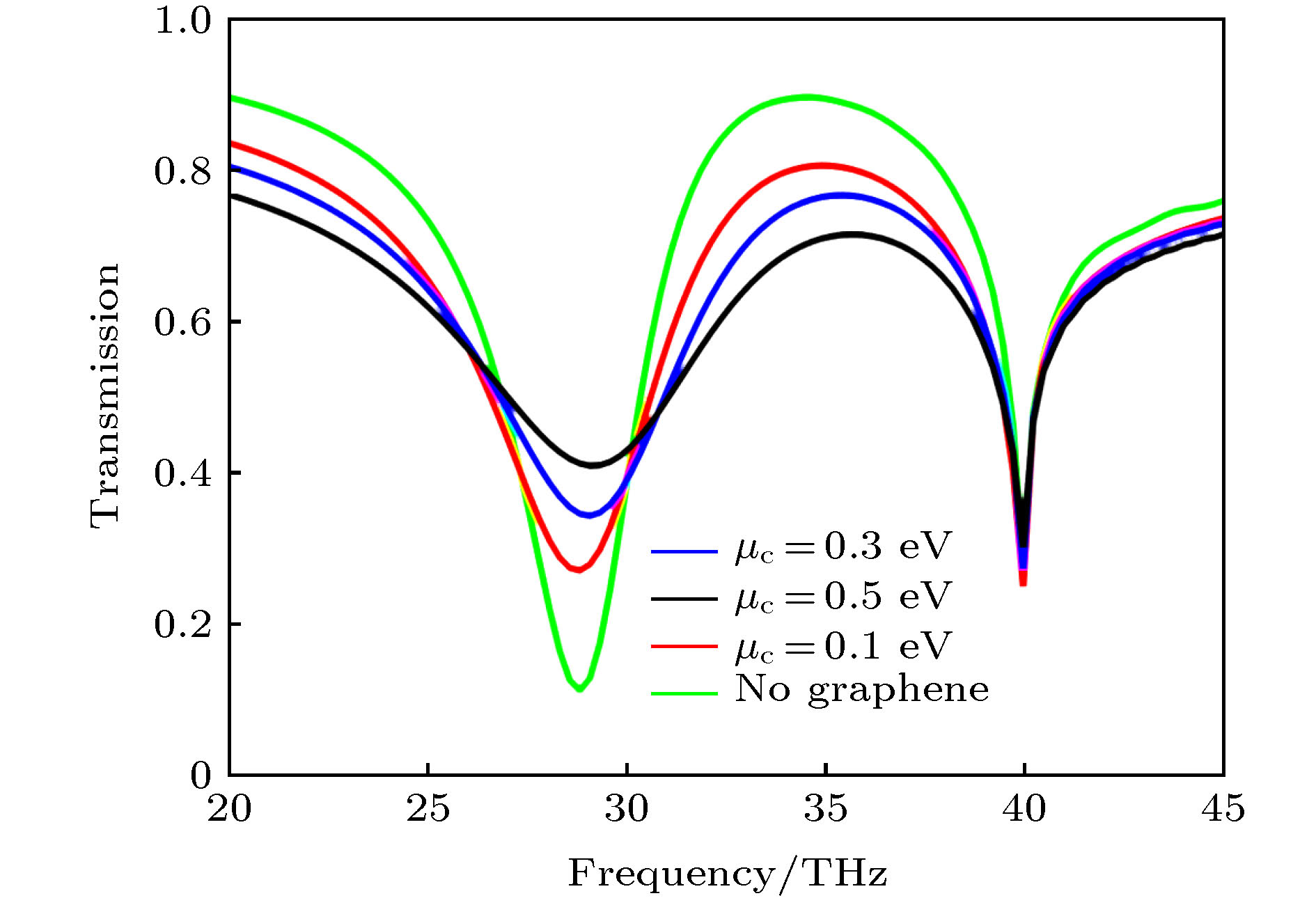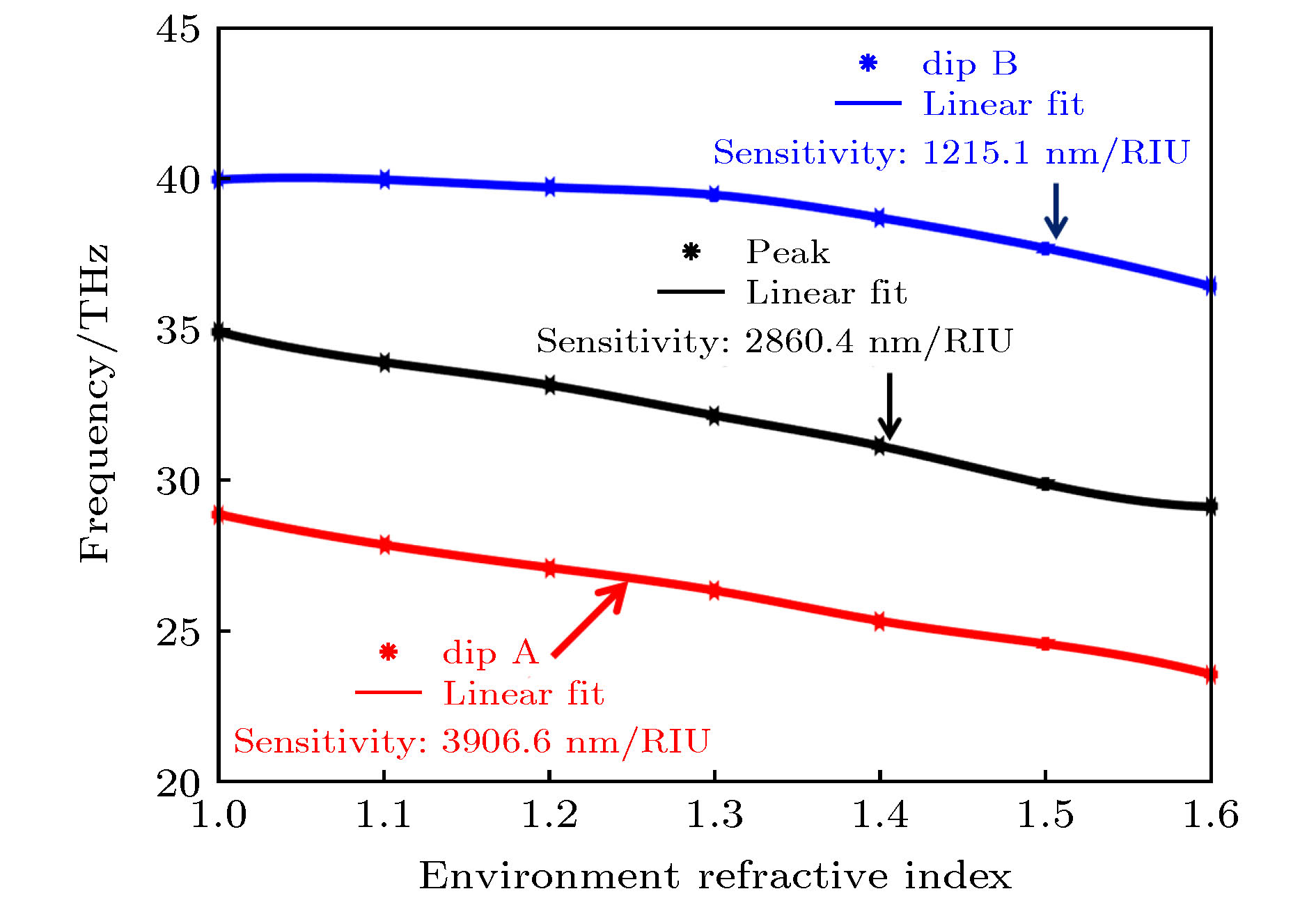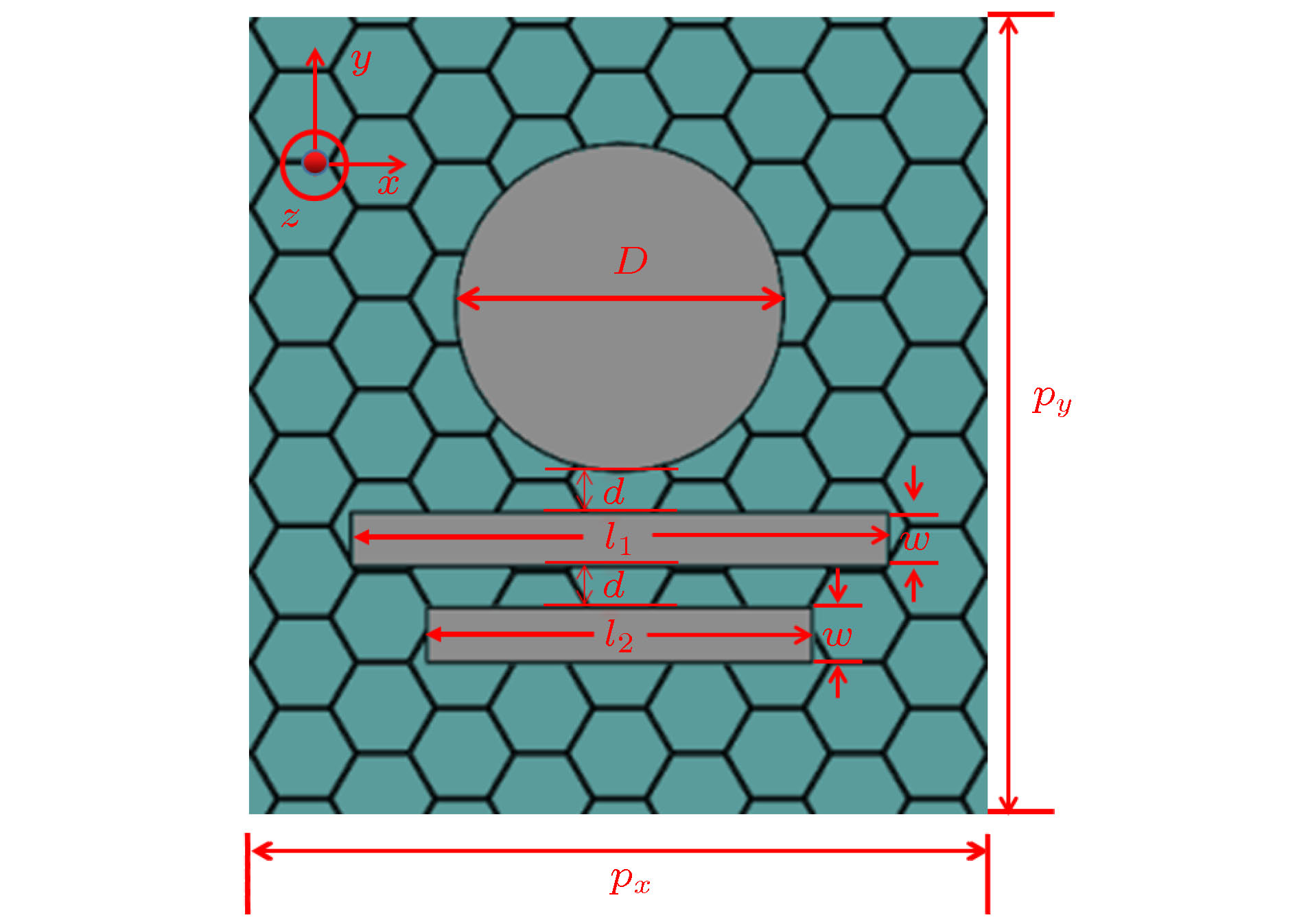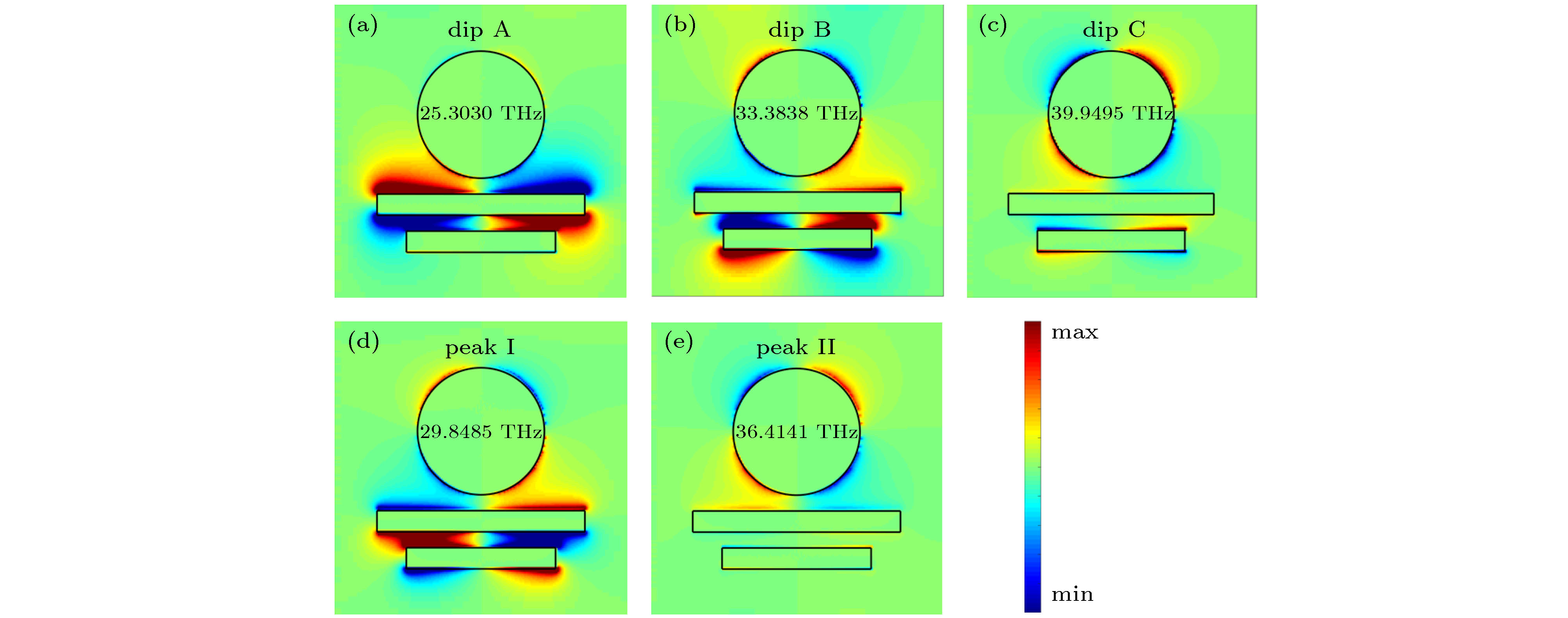-
In this paper, we have proposed a multiband plasmon-induced transparency (PIT) hybrid model based on silver nanorods, silver nanodisk and graphene. The electromagnetic properties are numerically and theoretically studied in this paper. The research results show that using the bright-bright mode coupling between silver nanorods and silver nanodisk, based on the weak hybridization effect induced by the detuning of each bright mode unit, the single-band, dual-band and triple-band PIT effects can be achieved. By changing the chemical potential of graphene, the tunability of the resonant frequencies and transmission amplitude can be achieved simultaneously in each PIT model. When the chemical potential of graphene is 0 in each of the three PIT models, that is, without graphene, the resonant frequencies of its transparent window is the smallest. As the chemical potential of graphene increases from 0 to 0.5 eV, the resonant notches of the transparent peak in all three PIT models are both enhanced and blue shifted. Especially, when the chemical potential is 0.5 eV, the absolute increment of resonance notch generated by the sing-band PIT transparent window is $\Delta f = 1.01$ THz and the relative increment is 2.91% while the largest absolute increment of resonance notch generated by the dual-band PIT transparent window is$\Delta f = 1.77$ THz and the largest relative increment is 5.97%. In the next place, when the chemical potential is 0.3 eV, the absolute increment of resonance notch generated by the triple-band PIT transparent window is$\Delta f = 1.26$ THz and the relative increment of the window is 4.02%.On the other hand, when graphene is existent in none of the three models, the resonance between silver nanodisk and silver nanorods, and the resonance between silver nanorods and silver nanorods are the weakest and the transmission amplitude of transparent window is the strongest in each of the three PIT models. Thereafter, with the increase of chemical potential, the number of surface charges on the silver nanodisk and silver nanorods increases and the intensity of electric field is enhanced. At the same time, the coupling strength between silver nanodisk and silver nanorods, and the coupling strength between silver nanorods and silver nanorods are also gradually enhanced. As a result, the transmission amplitude of each PIT model will gradually decrease. Especially, when the chemical potential is 0.5 eV, the amplitude modulation depth of the single-band PIT transparent peak is 20.2% and the amplitude modulation depth of the two transparent windows in dual-band PIT model are 31.2% and 24.2% respectively. In addition, when the chemical potential is 0.3 eV, the amplitude modulation depths of the three transparent windows in triple-band PIT model are 29.8%, 33.8%, and 20.5%. Finally, the sensing properties of the single-band PIT model are further investigated. The results show that the sensitivities of the model with refractive index of different background materials reach 3906.6 nm/RIU all, which provides a theoretical reference for the design of multiband filtering and ultrasensitive sensors. [1] Tassin P, Zhang L, Koschny T 2009 Phys. Rev. Lett. 102 4
[2] Li H J, Wang L L, Liu J Q 2013 Appl. Phys. Lett. 103 211104
 Google Scholar
Google Scholar
[3] Liu N, Langguth L, Weiss T 2009 Nat. Mater. 8 9
 Google Scholar
Google Scholar
[4] Papasimakis N, Fu Y H, Fedotov V A 2009 Appl. Phys. Lett. 94 211902
 Google Scholar
Google Scholar
[5] Safavi-Naeini A H, Alegre T P M, Chan J, Eichenfield M, Winger M, Lin Q, Hill J T, Chang D E, Painter O 2011 Nature 472 69
 Google Scholar
Google Scholar
[6] Qin M, Wang L L, Zhai X 2018 IEEE Photonic. Tech. L. 30 11
 Google Scholar
Google Scholar
[7] Ding J, Arigong B, Ren H 2014 Sci. Rep. 4 1
[8] Xiao S Y, Wang T, Liu T T 2018 Carbon 126 271
 Google Scholar
Google Scholar
[9] Shi C Y, He X Y, Peng J 2019 Opt. Laser Technol. 114 28
 Google Scholar
Google Scholar
[10] Ma Q C, Zhan Y W, Hong W Y 2018 Nanomaterials 9 7
 Google Scholar
Google Scholar
[11] Wei B Z, Jian S S 2018 Plasmonics 13 6
[12] Liu T T, Zhou C B, Cheng L 2019 J. Opt. 21 3
[13] Sun C, Dong Z W, Si J N 2017 Opt. Express 25 1242
 Google Scholar
Google Scholar
[14] Dong Z W, Sun C, Si J N 2017 Opt. Express 25 12251
 Google Scholar
Google Scholar
[15] 王越, 冷雁冰, 王丽 2018 67 097801
 Google Scholar
Google Scholar
Wang Y, Leng Y B, Wang L 2018 Acta Phys. Sin. 67 097801
 Google Scholar
Google Scholar
[16] Lao C D, Liang Y Y, Wang X J 2019 Nanomaterials 9 171
 Google Scholar
Google Scholar
[17] Wang X J, Meng H Y, Deng S Y 2019 Nanomaterials 9 385
 Google Scholar
Google Scholar
[18] Zhang X B, Wang G Q, Zhang L 2019 Crystals 9 146
 Google Scholar
Google Scholar
[19] Cen H F, Wang F Q, Liang R S 2018 Opt. Commun. 420 78
 Google Scholar
Google Scholar
[20] Hu X G, Yuan S, Armghan A 2017 J. Phys. D: Appl. Phys. 50 025301
 Google Scholar
Google Scholar
[21] Zhang S, Genov D A, Wang Y 2008 Phys. Rev. Lett. 101 047401
 Google Scholar
Google Scholar
[22] Berardi S Z, Rusen Y M, Kelly M 2012 Nat. Commun. 3 780
 Google Scholar
Google Scholar
[23] Habib M, Rashed A R, Ozbay E 2018 Opt. Mater. Express 8 1069
 Google Scholar
Google Scholar
[24] Shu C, Chen Q, Mei J 2019 Mater. Res. Express 6 055808
 Google Scholar
Google Scholar
[25] Zhang Z J, Yang J B, He X 2018 RSC Adv. 8 27746
 Google Scholar
Google Scholar
[26] Liu Y, Zhong R B, Lian Z 2018 Sci. Rep. 8 2828
 Google Scholar
Google Scholar
-
-
[1] Tassin P, Zhang L, Koschny T 2009 Phys. Rev. Lett. 102 4
[2] Li H J, Wang L L, Liu J Q 2013 Appl. Phys. Lett. 103 211104
 Google Scholar
Google Scholar
[3] Liu N, Langguth L, Weiss T 2009 Nat. Mater. 8 9
 Google Scholar
Google Scholar
[4] Papasimakis N, Fu Y H, Fedotov V A 2009 Appl. Phys. Lett. 94 211902
 Google Scholar
Google Scholar
[5] Safavi-Naeini A H, Alegre T P M, Chan J, Eichenfield M, Winger M, Lin Q, Hill J T, Chang D E, Painter O 2011 Nature 472 69
 Google Scholar
Google Scholar
[6] Qin M, Wang L L, Zhai X 2018 IEEE Photonic. Tech. L. 30 11
 Google Scholar
Google Scholar
[7] Ding J, Arigong B, Ren H 2014 Sci. Rep. 4 1
[8] Xiao S Y, Wang T, Liu T T 2018 Carbon 126 271
 Google Scholar
Google Scholar
[9] Shi C Y, He X Y, Peng J 2019 Opt. Laser Technol. 114 28
 Google Scholar
Google Scholar
[10] Ma Q C, Zhan Y W, Hong W Y 2018 Nanomaterials 9 7
 Google Scholar
Google Scholar
[11] Wei B Z, Jian S S 2018 Plasmonics 13 6
[12] Liu T T, Zhou C B, Cheng L 2019 J. Opt. 21 3
[13] Sun C, Dong Z W, Si J N 2017 Opt. Express 25 1242
 Google Scholar
Google Scholar
[14] Dong Z W, Sun C, Si J N 2017 Opt. Express 25 12251
 Google Scholar
Google Scholar
[15] 王越, 冷雁冰, 王丽 2018 67 097801
 Google Scholar
Google Scholar
Wang Y, Leng Y B, Wang L 2018 Acta Phys. Sin. 67 097801
 Google Scholar
Google Scholar
[16] Lao C D, Liang Y Y, Wang X J 2019 Nanomaterials 9 171
 Google Scholar
Google Scholar
[17] Wang X J, Meng H Y, Deng S Y 2019 Nanomaterials 9 385
 Google Scholar
Google Scholar
[18] Zhang X B, Wang G Q, Zhang L 2019 Crystals 9 146
 Google Scholar
Google Scholar
[19] Cen H F, Wang F Q, Liang R S 2018 Opt. Commun. 420 78
 Google Scholar
Google Scholar
[20] Hu X G, Yuan S, Armghan A 2017 J. Phys. D: Appl. Phys. 50 025301
 Google Scholar
Google Scholar
[21] Zhang S, Genov D A, Wang Y 2008 Phys. Rev. Lett. 101 047401
 Google Scholar
Google Scholar
[22] Berardi S Z, Rusen Y M, Kelly M 2012 Nat. Commun. 3 780
 Google Scholar
Google Scholar
[23] Habib M, Rashed A R, Ozbay E 2018 Opt. Mater. Express 8 1069
 Google Scholar
Google Scholar
[24] Shu C, Chen Q, Mei J 2019 Mater. Res. Express 6 055808
 Google Scholar
Google Scholar
[25] Zhang Z J, Yang J B, He X 2018 RSC Adv. 8 27746
 Google Scholar
Google Scholar
[26] Liu Y, Zhong R B, Lian Z 2018 Sci. Rep. 8 2828
 Google Scholar
Google Scholar
Catalog
Metrics
- Abstract views: 9026
- PDF Downloads: 135
- Cited By: 0


















 DownLoad:
DownLoad:
















